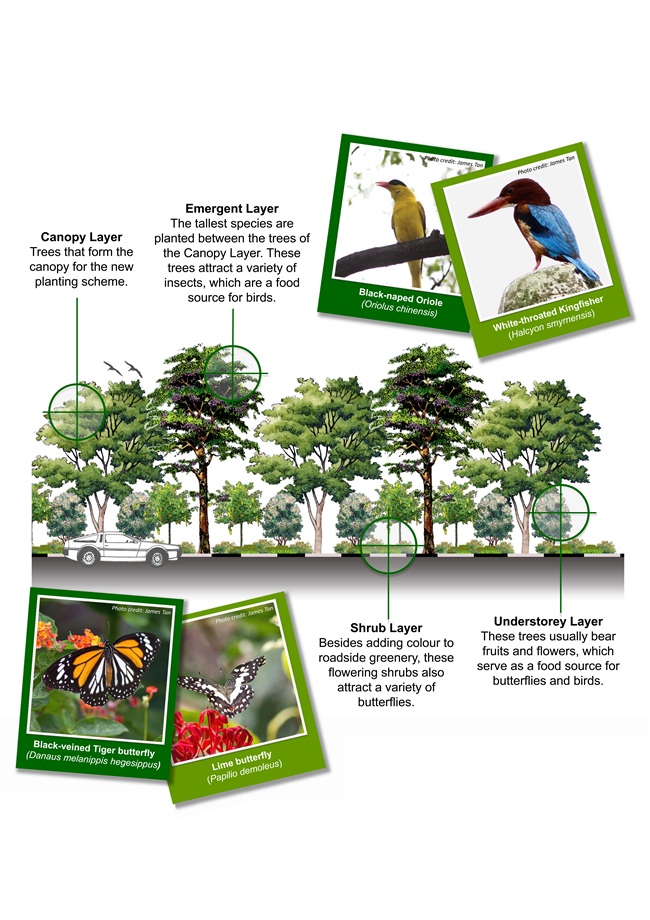Hey there!
A few months ago, I came across certain routes in Singapore called Nature Ways. No, it is not a brand of a health supplement I am refering to. Nature Ways are routes or pathways where greenery are planted in a way that replicates the natural forest structure so that animals can move between two green spaces (Nparks, 2015).


The rationale behind nature ways is simple but it requires careful planning as to which kind of plants should be used to successfully attract animals to use them. Regardless, I agree that this is an effective way to enhance biodiversity of Singapore as with increased accessibility between the various green spaces, the habitats of wildlife can be expanded to include more green areas. Moreover, nature ways bring nature closer to communities and provides opportunities for them to contribute in preserving the natural heritage. For instance, bird surveys are carried out and communities are engaged to use Nature Society Singapore (NSS) Bird Guide app to record sightings of birds in Kheam Hock nature way (Khoo & Chia, 2013).

Of course, nature ways are far from replacing the original natural forest that was lost during the process of urbanisation. However, it is still commendable that effort is being done to recreate the natural landscape and minimise the inevitable damage caused by development. I do wonder if nature ways can be expanded to include other species of animals as these routes are currently focused on attracting birds and butterflies. In addition, I wonder if the very idea of nature ways can also be applied to our normal streetscape such that the greenery of our streets can also be based on the structure of a forest. Am I getting a little too far-fetched? After all, it is not easy as the active and bustling nature of these streets may not provide a suitable environment of some of these animals (compared to the location of the current nature ways which are quieter). Well, I guess it is still worth a thought!

Nature ways re-emphasize the potential of greenery as important linkages between urban and nature. Currently, there are 7 nature ways and there will definitely be more to come in the future. Think about this: Singapore has an interconnected network of roads but wouldn’t it be cool if Singapore likewise has a wide network of nature ways? 🙂
Cheers!
♣ Johanah
References:
Nparks, (2015 January 5) Nature Ways, Retrieved on 16 August 2016, from: https://www.nparks.gov.sg/gardens-parks-and-nature/nature-ways
Khoo, k & Chia, C (2013) People & Places: Creating Ways for nature to travel, Retrieved on 18 August 2016, from: https://mygreenspace.nparks.gov.sg/creating-ways-for-nature-to-travel/
Lee Yueying
September 24, 2016 at 12:15 pmHi Johanah! I find your idea of an interconnected network of nature ways in Singapore really interesting! If it does materialise, this could really help Singapore become a “City in a Garden” and with nature brought so close to people, maybe more people will realise how wonderful and beautiful nature is. However considering how few major nature spaces there are in Singapore and how far some are from each other, I wonder how extensive the network can be and if some places can be successfully connected. Do you think a more extensive network of nature ways can work out?
Johanah Seow
September 24, 2016 at 10:02 pmHi Yueying!
Thank you for the comment, I am pleased that you like my post!
Unfortunately, I have this feeling that the further these nature spaces are from each other, the harder it is for these ways to work out. Firstly, limited space in Singapore makes it really hard for these nature ways to be constructed, this is because it would be more challenging to recreate the forest structure in a really small space. Moreover, these ways cannot be too close to our urban environment as well, as the active and bustling nature of our urban living may prevent them from using the nature ways which will render them ineffective. In Singapore where we are surrounded by high rise buildings, it would be difficult to find a route that can connect the two green areas, and at the same time, be sufficiently far from our urban environment. However, the current 7 nature ways have shown promising results and this gives us hope that an extensive network of nature ways is possible. I guess we can gradually expand the ways to connect environments further away from each other and slowly develop better methods or techniques in the process. In the long run, extensive network of nature ways can possibly work out. 🙂